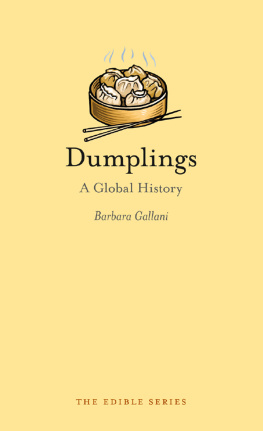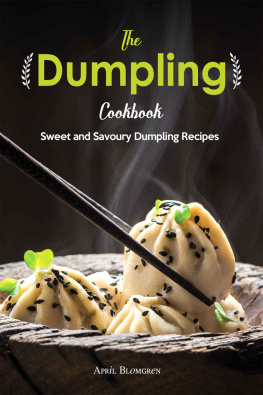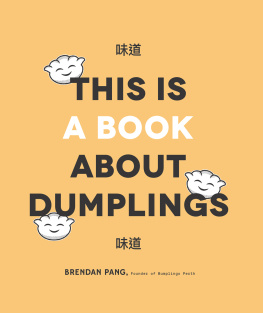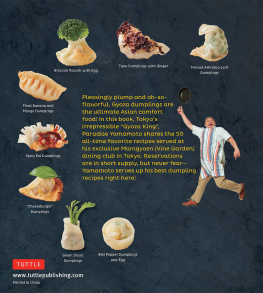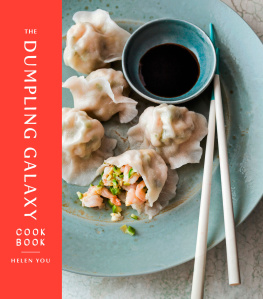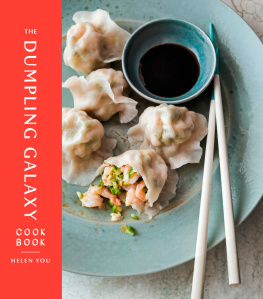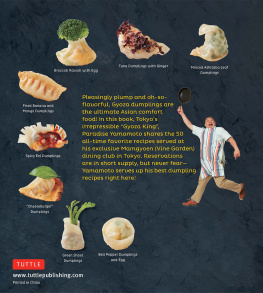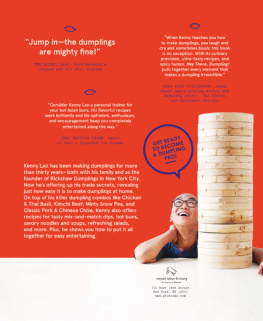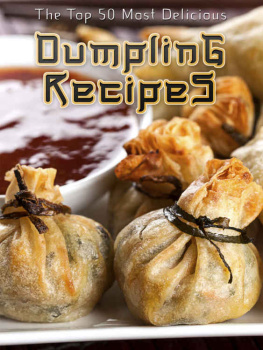DUMPLINGS

Edible
Series Editor: Andrew F. Smith
EDIBLE is a revolutionary series of books dedicated to food and drink that explores the rich history of cuisine. Each book reveals the global history and culture of one type of food or beverage.
Already published
Apple Erika Janik Barbecue Jonathan Deutsch and Megan
J. Elias Beef Lorna Piatti-Farnell Beer Gavin D. Smith
Brandy Becky Sue Epstein Bread William Rubel
Cake Nicola Humble Caviar Nichola Fletcher Champagne
Becky Sue Epstein Cheese Andrew Dalby Chocolate Sarah
Moss and Alexander Badenoch Cocktails Joseph M. Carlin
Curry Colleen Taylor Sen Dates Nawal Nasrallah Dumplings
Barbara Gallani Eggs Diane Toops Figs David C. Sutton
Game Paula Young Lee Gin Lesley Jacobs Solmonson
Hamburger Andrew F. Smith Herbs Gary Allen
Hot Dog Bruce Kraig Ice Cream Laura B. Weiss
Lemon Toby Sonneman Lobster Elisabeth Townsend
Milk Hannah Velten Mushroom Cynthia D. Bertelsen
Nuts Ken Albala Offal Nina Edwards Olive Fabrizia Lanza
Oranges Clarissa Hyman Pancake Ken Albala
Pie Janet Clarkson Pineapple Kaori O Connor
Pizza Carol Helstosky Pork Katharine M. Rogers
Potato Andrew F. Smith Pudding Jeri Quinzio Rice Renee
Marton Rum Richard Foss Salmon Nicolaas Mink Sandwich
Bee Wilson Sauces Maryann Tebben Soup Janet Clarkson
Spices Fred Czarra Sugar Andrew F. Smith Tea Helen Saberi
Tequila Ian Williams Truffle Zachary Nowak Vodka Patricia
Herlihy Whiskey Kevin R. Kosar Wine Marc Millon
Dumplings
A Global History
Barbara Gallani
REAKTION BOOKS
To my dumpling-loving family
Published by Reaktion Books Ltd
33 Great Sutton Street
London EC1V 0DX, UK
www.reaktionbooks.co.uk
First published 2015
Copyright Barbara Gallani 2015
All rights reserved
No part of this publication may be reproduced, stored in a retrieval system, or transmitted, in any form or by any means, electronic, mechanical, photocopying, recording or otherwise, without the prior permission of the publishers
Page references in the Photo Acknowledgements and
Index match the printed edition of this book.
Printed and bound in China
A catalogue record for this book is available from the British Library
eISBN: 9781780234632
Contents

What is a Dumpling?

The word dumpling can mean many different things in the culinary world: fluffy balls of wheat flour and animal fat floating to the surface of hearty stews; delicate parcels of dough filled with meat or vegetables and then steamed; or firm little lumps of potato, egg and flour served in a thick sauce. Savoury and sweet dumplings are widespread across the world, with simple varieties served as an everyday meal in the home or in school and factory canteens. More elaborate versions are prepared once or twice a year for celebrations and festivals.
Any official definition of the word dumpling is likely only to partially describe what is an extraordinary variety of foods. This difficulty in finding a universal definition is also caused by the fact that the English word dumpling is used as a shortcut translation for a long list of foods that have very similar characteristics but also very well-defined identities and vocabulary in the language of the country from which they come. The glossary at the end of this book provides an idea of these differences and similarities. A chef in Chiang Mai, Thailand well-versed in Asian dumplings and in their sometimes very subtle differences once said to me, pointing at a number of bamboo steamers on a dim sum trolley, Chinese dumplings: same same but different. This popular Thai saying seemed quite appropriate in the circumstances.
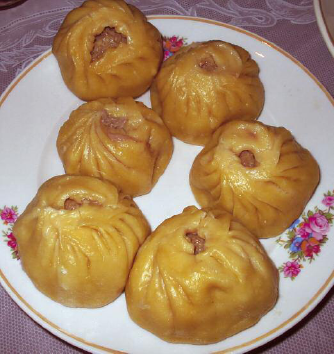
Mongolian buuz filled with mutton or yak and steamed.
In order to match the meaning of the original language, some translations are required to be less telegraphic than the simple word dumpling, and might extend to a fuller description of the food including its ingredients, cooking method and presentation. The single Italian word carmelle, for example, captures very succinctly all the following characteristics: a dumpling made of a thin wheat wrap, ricotta cheese and spinach filling, shaped as a wrapped boiled sweet, boiled in water, served with melted butter and sage, and typical of the town of Piacenza, northern Italy. The English translation, correct but far from comprehensive, would simply be Italian type of filled dumpling.
The Oxford English Dictionary limits its definition to a small savoury ball of dough, excluding other shapes and omitting any reference to the possible presence of a filling. On the other hand, it accepts boiled, fried and baked in a casserole as suitable cooking methods. For the purpose of this book, my definition of a dumpling, which I have developed over many years of research and in-depth conversations with chefs, cooks and enthusiasts, as well as a fair amount of eating, extends to both unfilled and filled varieties, including what is sometimes described as filled pasta. However, I prefer to exclude frying and baking as cooking methods, since these result in what people usually recognize as fritters or small pasties rather than dumplings.
Many unfilled dumplings are very easy to prepare, being nothing more than a few basic ingredients mixed together, dropped into boiling water, drained and served with a stew or rich sauce. To make things even simpler, they can also be cooked directly in the broth or casserole in which they will be served. This type of dumpling is used to add bulk to a meal and as an alternative to potatoes, pasta or rice. The simplest recipes include just wheat flour and water; other typical ingredients include breadcrumbs and fat, sometimes with the addition of herbs, cheese or egg. In Africa, wheat flour is replaced by millet, yam or other local starchy ingredients, while in Central, Eastern and Northern Europe potatoes tend to be the main ingredient of choice. Unfilled dumplings are not ideally served on their own, since they taste bland and, although filling, are not particularly nutritious.
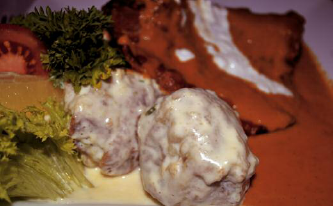
Many unfilled dumplings are simple homogeneous mixtures of a very few common ingredients, cooked in boiling water and served with roasted meat and gravy or stews.
Filled dumplings consist of a layer of dough wrapped around a seemingly infinite variety of juicy and tasty fillings. There is no limit to the imagination when it comes to possible ingredients, the only constraints being availability clearly linked to geography and seasonality and tradition. Also, once the art of preparing and rolling the dough and shaping individual dumplings is mastered, depending on whether the dumplings are intended for a quick and simple everyday meal or for a special occasion, more unusual and elaborate combinations of ingredients and flavours can be developed. Filled dumplings are a complete course in themselves and do not need any substantial accompaniment beside the filling; they are served with the simplest of sauces, or with no sauce at all.

